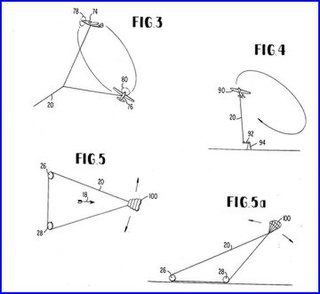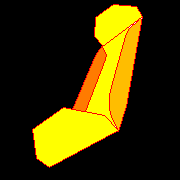
An aircraft is a vehicle that is able to fly by gaining support from the air. It counters the force of gravity by using either static lift or the dynamic lift of an airfoil, or, in a few cases, direct downward thrust from its engines. Common examples of aircraft include airplanes, helicopters, airships, gliders, paramotors, and hot air balloons.

Hang gliding is an air sport or recreational activity in which a pilot flies a light, non-motorised, heavier-than-air aircraft called a hang glider. Most modern hang gliders are made of an aluminium alloy or composite frame covered with synthetic sailcloth to form a wing. Typically the pilot is in a harness suspended from the airframe, and controls the aircraft by shifting body weight in opposition to a control frame.

A wing is a type of fin that produces lift while moving through air or some other fluid. Accordingly, wings have streamlined cross-sections that are subject to aerodynamic forces and act as airfoils. A wing's aerodynamic efficiency is expressed as its lift-to-drag ratio. The lift a wing generates at a given speed and angle of attack can be one to two orders of magnitude greater than the total drag on the wing. A high lift-to-drag ratio requires a significantly smaller thrust to propel the wings through the air at sufficient lift.

Unpowered aircraft can remain airborne for a significant period of time without onboard propulsion. They can be classified as gliders, lighter-than-air balloons and tethered kites. In the case of kites, lift is obtained by tethering to a fixed or moving object, perhaps another kite, to obtain a flow of wind over the lifting surfaces. In the case of balloons, lift is obtained through inherent buoyancy and the balloon may or may not be tethered. Free balloon flight has little directional control. Gliding aircraft include sailplanes, hang gliders, and paragliders that have full directional control in free flight.

A fixed-wing aircraft is a heavier-than-air flying machine, such as an airplane, which is capable of flight using aerodynamic lift. Fixed-wing aircraft are distinct from rotary-wing aircraft, and ornithopters. The wings of a fixed-wing aircraft are not necessarily rigid; kites, hang gliders, variable-sweep wing aircraft, and airplanes that use wing morphing are all classified as fixed wing.

Paragliding is the recreational and competitive adventure sport of flying paragliders: lightweight, free-flying, foot-launched glider aircraft with no rigid primary structure. The pilot sits in a harness or in a cocoon-like 'pod' suspended below a fabric wing. Wing shape is maintained by the suspension lines, the pressure of air entering vents in the front of the wing, and the aerodynamic forces of the air flowing over the outside.

A model aircraft is a physical model of an existing or imagined aircraft, and is built typically for display, research, or amusement. Model aircraft are divided into two basic groups: flying and non-flying. Non-flying models are also termed static, display, or shelf models.

Ridge lift is created when a wind strikes an obstacle, usually a mountain ridge or cliff, that is large and steep enough to deflect the wind upward.

A paper plane is a toy aircraft, usually a glider, made out of single folded sheet of paper or paperboard. It typically takes the form of a simple nose-heavy triangle thrown like a dart.

Anton Flettner was a German aviation engineer and inventor. Born in Eddersheim, Flettner made important contributions to airplane, helicopter, vessel, and automobile designs.
Airborne wind energy (AWE) is the direct use or generation of wind energy by the use of aerodynamic or aerostatic lift devices. AWE technology is able to harvest high altitude winds, in contrast to wind turbines, which use a rotor mounted on a tower.

A walkalong glider is a lightweight, slow-flying model aircraft designed to be kept aloft by controllable slope soaring in the rising air generated by the pilot who walks along with the glider as it flies, usually holding a paddle. Hands or even the forehead can also be used to create an updraft. This type of soaring differs from other types of slope soaring in that the orographic lift is following the plane as it flies in the air and thus no other wind is required.

A Flettner rotor is a smooth cylinder with disc end plates which is spun along its long axis and, as air passes at right angles across it, the Magnus effect causes an aerodynamic force to be generated in the direction perpendicular to both the long axis and the direction of airflow. The rotor sail is named after the German aviation engineer and inventor Anton Flettner, who started developing the rotor sail in the 1920s.
Gliding flight is heavier-than-air flight without the use of thrust; the term volplaning also refers to this mode of flight in animals. It is employed by gliding animals and by aircraft such as gliders. This mode of flight involves flying a significant distance horizontally compared to its descent and therefore can be distinguished from a mostly straight downward descent like a round parachute.

A glider is a fixed-wing aircraft that is supported in flight by the dynamic reaction of the air against its lifting surfaces, and whose free flight does not depend on an engine. Most gliders do not have an engine, although motor-gliders have small engines for extending their flight when necessary by sustaining the altitude with some being powerful enough to take off by self-launch.

Kites are tethered flying objects which fly by using aerodynamic lift, requiring wind for generation of airflow over the lifting surfaces.

Controllable-slope soaring is a type of slope soaring where a slope is made to follow a walkalong glider, both sustaining and controlling the glider's trajectory by modifying the wind in the vicinity of the airplane.
Unpowered flight is the ability to stay airborne for a period of time without using any power source. There are several types of unpowered flight. Some have been exploited by nature, others by humankind, and some by both.

Crosswind kite power is power derived from airborne wind-energy conversion systems or crosswind kite power systems (CWKPS). The kite system is characterized by energy-harvesting parts flying transverse to the direction of the ambient wind, i.e., to crosswind mode; sometimes the entire wing set and tether set is flown in crosswind mode. From toy to power-grid-feeding sizes, these systems may be used as high-altitude wind power (HAWP) devices or low-altitude wind power (LAWP) devices without having to use towers. Flexible wings or rigid wings may be used in the kite system. A tethered wing, flying in crosswind at many times wind speed, harvests wind power from an area that exceeds the wing's total area by many times.
A rotor wing is a lifting rotor or wing which spins to provide aerodynamic lift. In general, a rotor may spin about an axis which is aligned substantially either vertically or side-to-side (spanwise). All three classes have been studied for use as lifting rotors and several variations have been flown on full-size aircraft, although only the vertical-axis rotary wing has become widespread on rotorcraft such as the helicopter.















